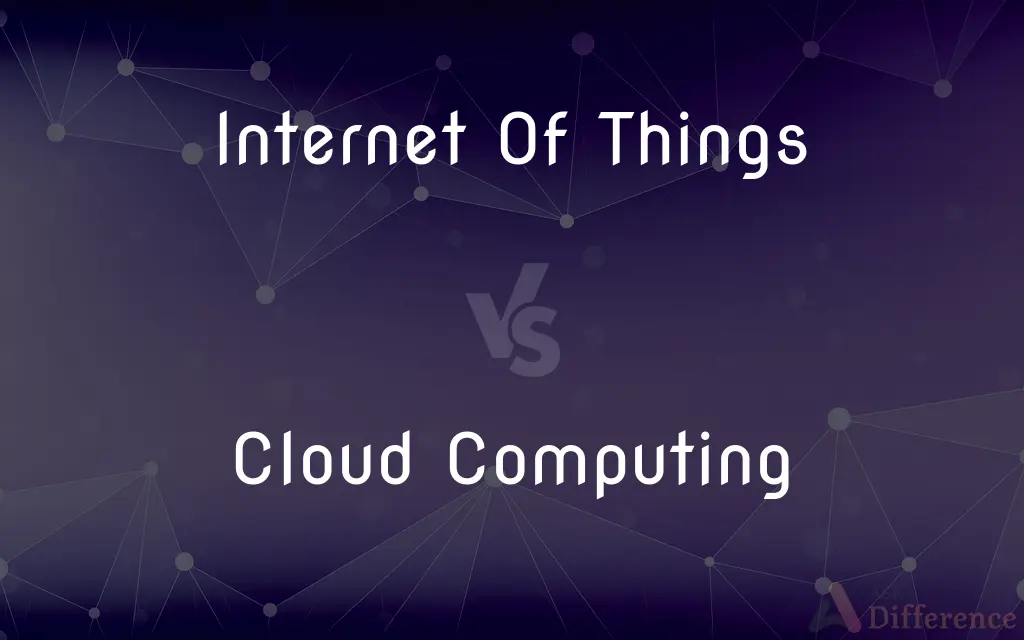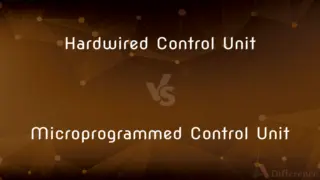Internet Of Things vs. Cloud Computing — What's the Difference?
Edited by Tayyaba Rehman — By Fiza Rafique — Published on December 27, 2023
Internet Of Things (IoT) refers to interconnected devices communicating over the internet, while Cloud Computing provides on-demand computing resources via the internet.

Difference Between Internet Of Things and Cloud Computing
Table of Contents
ADVERTISEMENT
Key Differences
The Internet Of Things (IoT) is a concept that revolves around connecting physical devices, from household appliances to industrial machinery, to the internet. These devices collect and share data, allowing them to interact with other devices and systems. Cloud Computing, on the other hand, is about delivering computing services—like storage, processing, and software—over the internet, commonly referred to as "the cloud."
Whereas IoT emphasizes connectivity and the vast web of devices that can communicate with one another, Cloud Computing focuses on providing scalable and flexible computing resources without the need to own or manage physical infrastructure. The two concepts, however, are not mutually exclusive. Often, Internet Of Things devices rely on Cloud Computing infrastructure to store, process, and analyze the vast amounts of data they generate.
The ever-expanding network of IoT devices generates a huge amount of data. For this data to be useful, it needs to be processed, analyzed, and stored. This is where Cloud Computing steps in. The cloud provides the necessary infrastructure for these operations, eliminating the need for businesses or individuals to maintain their own costly hardware. In essence, while IoT speaks to the "things" or devices, Cloud Computing refers to the backend infrastructure that supports these devices.
Lastly, both IoT and Cloud Computing are integral parts of the current technological landscape. The Internet Of Things promises a future where all devices are interconnected, smart, and responsive. At the same time, Cloud Computing acts as the backbone, providing the necessary computing muscle to ensure that these devices operate seamlessly.
Comparison Chart
Primary Focus
Interconnectivity of devices
Delivery of computing services over the internet
ADVERTISEMENT
Data Handling
Generates and transmits data
Processes, stores, and analyzes data
Infrastructure Needs
Requires internet connection and sensors
Requires data centers and network connectivity
User Interaction
Direct, through devices and systems
Indirect, via services and platforms
Key Benefits
Real-time monitoring and automation
Scalability, flexibility, and cost-effectiveness
Compare with Definitions
Internet Of Things
Platform for devices to operate intelligently and autonomously.
Cars in the realm of the Internet Of Things can self-diagnose issues.
Cloud Computing
Delivery of computing services over the internet.
Her company uses Cloud Computing to backup important files.
Internet Of Things
Network of physical devices connected to the internet.
Smart thermostats are part of the Internet Of Things, adjusting temperatures based on user habits.
Cloud Computing
Alternative to owning and maintaining physical servers.
Startups often prefer Cloud Computing due to its cost-effectiveness.
Internet Of Things
Integration of sensors, software, and other technologies.
Security systems now leverage the Internet Of Things to provide real-time alerts.
Cloud Computing
Infrastructure that allows global access to data and applications.
He accessed his work documents abroad thanks to Cloud Computing.
Internet Of Things
Systems that collect and exchange data automatically.
With the Internet Of Things, her refrigerator can notify her when she's out of milk.
Cloud Computing
Access to processing power, storage, and applications on demand.
With Cloud Computing, they scaled their website's resources during high traffic periods.
Internet Of Things
Interconnection of everyday objects to enhance automation.
The Internet Of Things has made it possible to control lights using voice commands.
Cloud Computing
Platform providing scalability, flexibility, and remote computing.
The software-as-a-service model is a popular facet of Cloud Computing.
Common Curiosities
What's the main aim of the Internet Of Things?
It aims to interconnect devices for improved automation and data exchange.
Why is security a concern in both IoT and Cloud Computing?
Because data breaches can expose sensitive information and compromise devices.
Is a smartwatch an example of IoT?
Yes, it's an IoT device that connects to the internet and other devices.
How do IoT devices communicate?
Typically through internet protocols, wireless networks, or other communication technologies.
Are there different types of Cloud Computing deployment models?
Yes, including public, private, hybrid, and community clouds.
What's the cost model for Cloud Computing?
Often pay-as-you-go, only paying for the services and resources used.
What are popular services in Cloud Computing?
Services include Infrastructure-as-a-Service, Platform-as-a-Service, and Software-as-a-Service.
Can IoT devices work without Cloud Computing?
While possible, many IoT devices rely on the cloud for data storage and analysis.
Can individuals use Cloud Computing?
Yes, services like cloud storage and online apps are common uses for individuals.
Is internet access mandatory for Cloud Computing?
While some offline functionalities exist, core features require internet access.
How does Cloud Computing support businesses?
It provides scalable IT resources without the capital costs of hardware.
What's a potential disadvantage of IoT?
Privacy concerns, as interconnected devices can gather vast amounts of personal data.
How can businesses benefit from IoT?
Through improved efficiency, real-time insights, and new revenue streams.
How has IoT impacted smart homes?
It's enabled automation and integration of various home devices and systems.
Which is growing faster: IoT or Cloud Computing?
Both are rapidly growing, but IoT's expansion is notably due to decreasing device costs and increasing connectivity.
Share Your Discovery

Previous Comparison
Hardwired Control Unit vs. Microprogrammed Control Unit
Next Comparison
Radial Symmetry vs. Bilateral SymmetryAuthor Spotlight
Written by
Fiza RafiqueFiza Rafique is a skilled content writer at AskDifference.com, where she meticulously refines and enhances written pieces. Drawing from her vast editorial expertise, Fiza ensures clarity, accuracy, and precision in every article. Passionate about language, she continually seeks to elevate the quality of content for readers worldwide.
Edited by
Tayyaba RehmanTayyaba Rehman is a distinguished writer, currently serving as a primary contributor to askdifference.com. As a researcher in semantics and etymology, Tayyaba's passion for the complexity of languages and their distinctions has found a perfect home on the platform. Tayyaba delves into the intricacies of language, distinguishing between commonly confused words and phrases, thereby providing clarity for readers worldwide.
















































